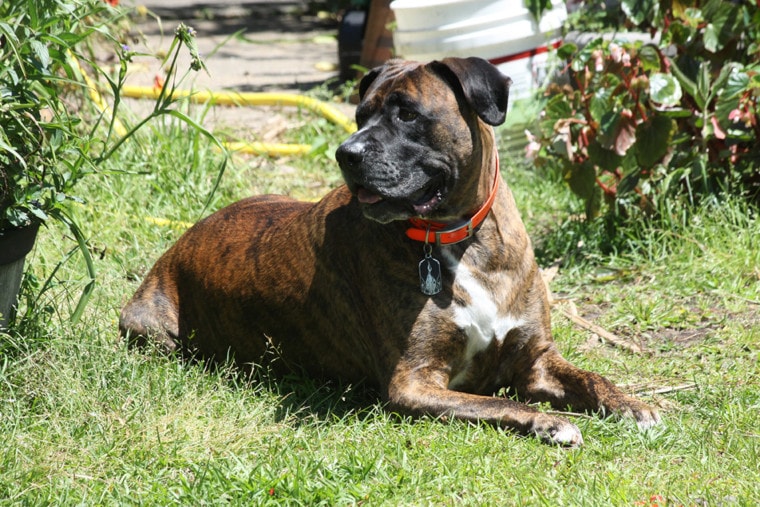
Click to Skip Ahead
Also known as “tiger striped,” brindle dogs are quite striking. The breeds that have the genes necessary for this coat coloring tend to be red, brown, silver, black, fawn, or gray, with the distinctive stripy pattern throughout their fur. Depending on their coat color and whether white is mixed in, brindle dogs can be unique and eye-catching.
The brindle pattern isn’t limited to massive dogs like the Great Dane and the Cane Corso; you can also find brindle in breeds better known for other colors, including the Akita. We hope that this list of 20 brindle dog breeds introduces you to a few of the breeds that can have this beautiful coat pattern.
How Are Brindle Dogs Classified?
Whether a dog can be brindle depends on their genetics. Since it’s recessive, only breeds that carry the genes needed for the coat pattern are likely to show it. So, even breeds that carry the genes might not be brindle if they also have genes for a more dominant coat color.
Some breeds, such as the Dutch Shepherd, were specifically developed to have a brindle coat to distinguish them from similar breeds. For other breeds, such as the Cane Corso, the brindle patterning is a natural variation. Dogs that don’t carry the genes at all won’t be brindle, though you can sometimes see the coloring in mixed breeds.
The 20 Brindle Dog Breeds
1. Akita

| Origin: | Early 17th century, Japan |
| Lifespan: | 10–14 years |
| Height: | 24–28 inches |
The Akita is a treasured breed throughout the world but especially in Japan, where they originated. They were said to have been developed by a nobleman who was banished to Honshu Island, where he served as a provincial ruler and began developing a hunting dog. Since then, the Akita has been a hard worker and a symbol of happiness and longevity.
You might be more familiar with the fawn-and-white coat coloring of the Akita, especially if you’re a fan of the 2009 movie dedicated to the loyal Hachiko. But brindle is also one of the recognized standards.
2. Anatolian Shepherd

| Origin: | Anatolia (Turkey) |
| Lifespan: | 11–13 years |
| Height: | 27–29 inches |
One of the largest dogs on this list is the hardworking Anatolian Shepherd. These livestock guardians have been around for centuries and were developed in Anatolia, the Asian part of Turkey, to protect sheep and goats.
This hardy breed was bred to withstand hot summers and cold winters without wavering in their dedication to the livestock herds that they watched over. Their skills led to them being introduced to the U.S.A. just before World War II.
Brindle is one of the AKC-recognized standards for the breed’s coat color, along with fawn, liver, and white.
3. American Bulldog
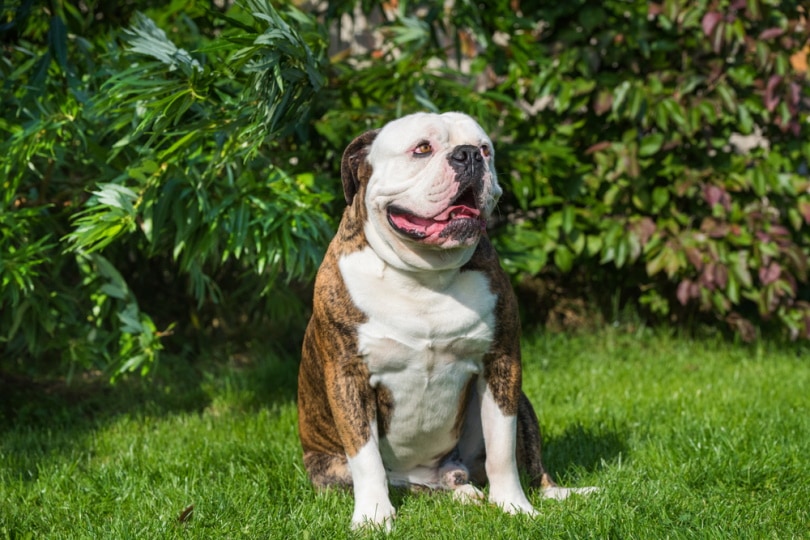
| Origin: | 18th century, U.S.A. |
| Lifespan: | 10–12 years |
| Height: | 20–25 inches |
Originally bred as a working farm dog, the American Bulldog has been around since the 1700s. They were prized for their skills in helping farmers and ranchers by catching feral livestock and handling other farm tasks. Although the breed almost died out after both world wars, they were saved by John D. Johnson and Alan Scott.
White is the main base color for the American Bulldog. The AKC does recognize brindle as a color for their markings, though, and many American Bulldogs have brindle-colored patches around their eyes and on their body.
4. American Staffordshire Terrier
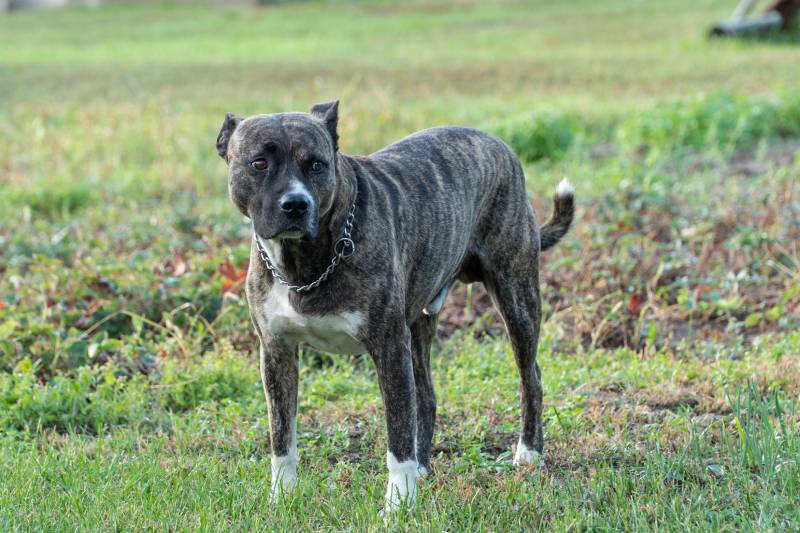
| Origin: | Mid-19th century, U.S.A. |
| Lifespan: | 12–16 years |
| Height: | 17–19 inches |
Developed from the Staffordshire Bull Terrier and once known as the same breed, the American Staffordshire Terrier—or “AmStaff,” as they’re affectionately nicknamed—is often still confused with their English cousins. They’re a slightly larger breed than the Staffordshire Bull Terrier but share the same friendliness, confidence, and intelligence. The breed is also mellower today than their distant ancestors, which were bred for pit-fighting in the U.K.
AmStaffs have various recognized coat colors and patterns. Along with solid coat colors, the AKC recognizes brindle in red, blue, fawn, black, brown, and liver.
5. Basenji

| Origin: | Africa |
| Lifespan: | 13–14 years |
| Height: | 16–17 inches |
As one of the oldest breeds recognized by the AKC, the Basenji can be traced back to ancient Egypt, Babylonian, and Mesopotamian art. They’re a hound breed and excel in hunting, sprinting, and tracking. The Basenji is a cat-like dog with an impressive ability to jump vertically and a tendency to groom themselves like a cat.
Brindle and white is one of the recognized coat patterns for the breed, and some Basenjis can even be black brindle.
6. Boxer
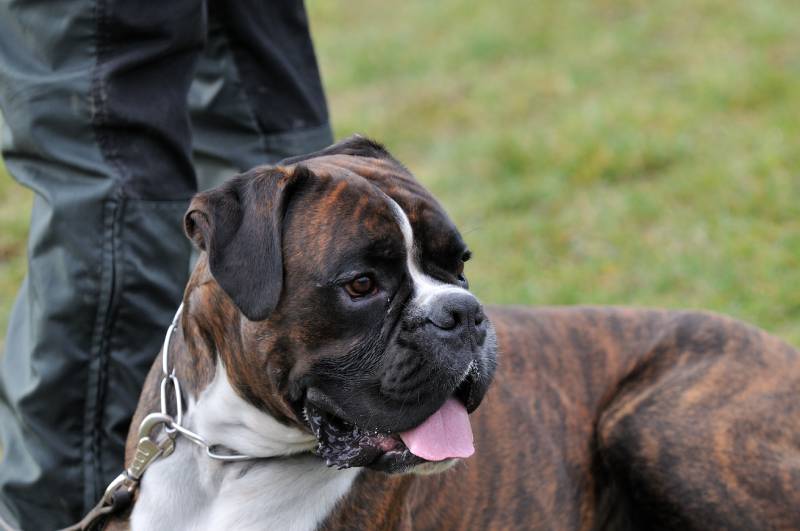
| Origin: | Late 19th century, Germany |
| Lifespan: | 10–12 years |
| Height: | 21.5–25 inches |
The origins of the Boxer can be traced back to 2,500 B.C. to Assyrian war dogs, but most of the traits that we know in the breed today are a result of German breeding in the late 19th century. They were developed from Germany’s big-game hunter, the Bullenbeisser, or “bull-biter,” a breed developed for catching and holding bison, bears, and wild boar.
When the German nobility fell out of favor, the hunting dogs were bred with English Mastiff-type dogs to eventually form the Boxer. Brindle and fawn are the only two colors recognized by the AKC.
7. Bullmastiff
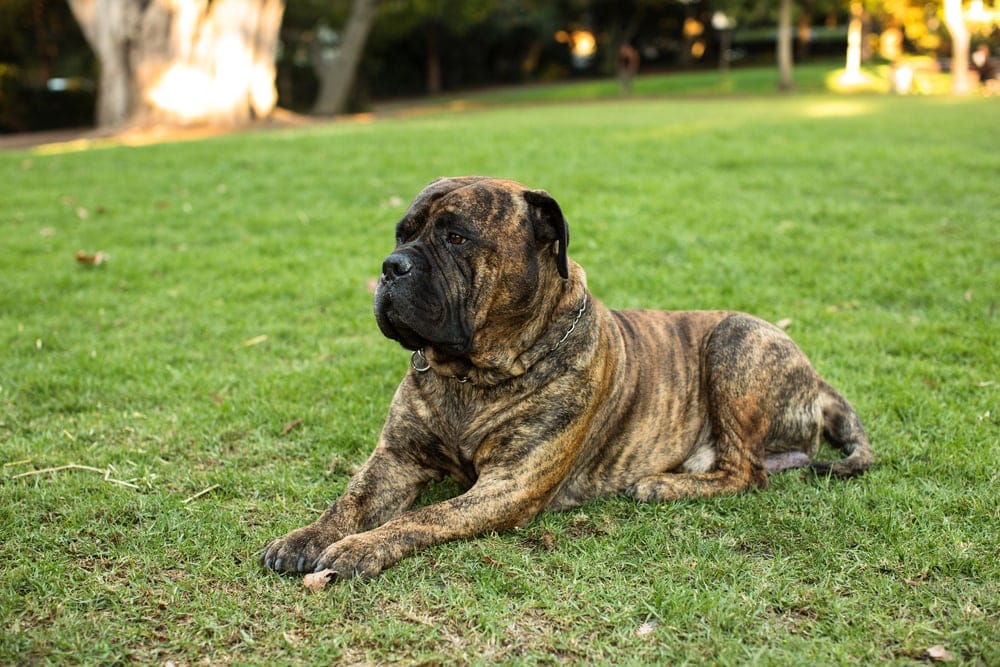
| Origin: | 19th century, U.K. |
| Lifespan: | 7–9 years |
| Height: | 24–27 inches |
Although many English Bulldog- and Mastiff-type breeds started as pit fighters, the Bullmastiff was a guardian first. Descended from the Bulldog and the Mastiff, the aptly named Bullmastiff quickly earned the nickname, “The Gamekeeper’s Night Dog.” They were bred to be swift, confident, and fierce guardians of English estates. These dogs protected the nobility and their land from poachers by holding but not harming the intruders and using their size to intimidate them.
The Bullmastiff is found in fawn, red, and red fawn, with brindle recognized as a variation of all three colors.
8. Bull Terrier
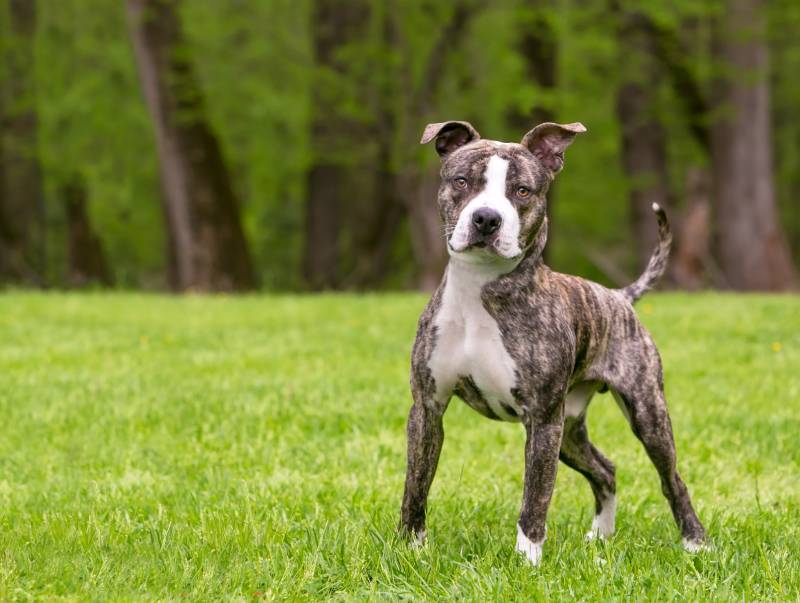
| Origin: | 13th century, U.K. |
| Lifespan: | 12–13 years |
| Height: | 21–22 inches |
Recognized by their muscled bodies and the distinctive egg shape of their head, the Bull Terrier began in the U.K. during the pit fighting era between the 13th and 19th centuries. They were one of the faster breeds developed from the Bulldog, as a way to create a perfect pit-fighting breed to entertain the British public.
Many colors and coat patterns are part of the recognized breed standard. Brindle is accepted on its own, in black, and mixed with white.
9. Cairn Terrier
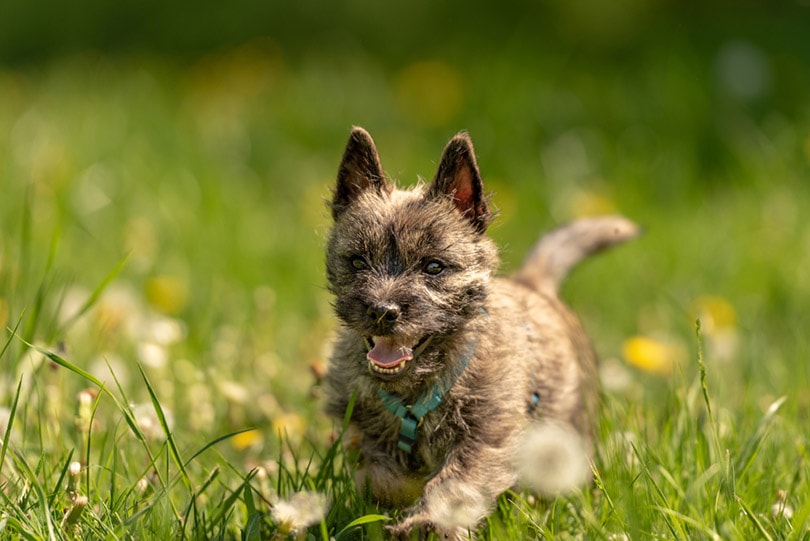
| Origin: | 19th century, Scotland |
| Lifespan: | 13–15 years |
| Height: | 9.5–10 inches |
Although the Cairn Terrier has been around since the 1600s, they were only given their name officially in the 1800s. Originally, they were bred to chase rodents out of burial sites in the Scottish Highlands. A “cairn” and the breed’s namesake was the Scottish word for the stack of stones used to mark the graves. These terriers would also work in packs to hunt foxes.
The Cairn Terrier is found in cream, gray, red, silver, wheaten, and black, with brindle being one of the common varieties for all six recognized colors.
10. Cane Corso

| Origin: | Ancient Rome |
| Lifespan: | 9–12 years |
| Height: | 23.5–27.5 inches |
The Cane Corso, as their appearance suggests, has always been a fiercely loyal and protective breed. They might be big softies for their families these days, but they weren’t always meant to be companion animals. When they were first developed from the Greek Mollosus dogs by the Romans, the Cane Corso were war dogs and Colosseum fighters. After the dissolution of the Roman Empire, they became farm dogs.
Their coloring goes a long way in increasing their intimidating appearance. Along with the solid black, gray, fawn, and red shades of their fur, the Cane Corso can also be black brindle, gray brindle, and chestnut brindle.
11. Cardigan Welsh Corgi
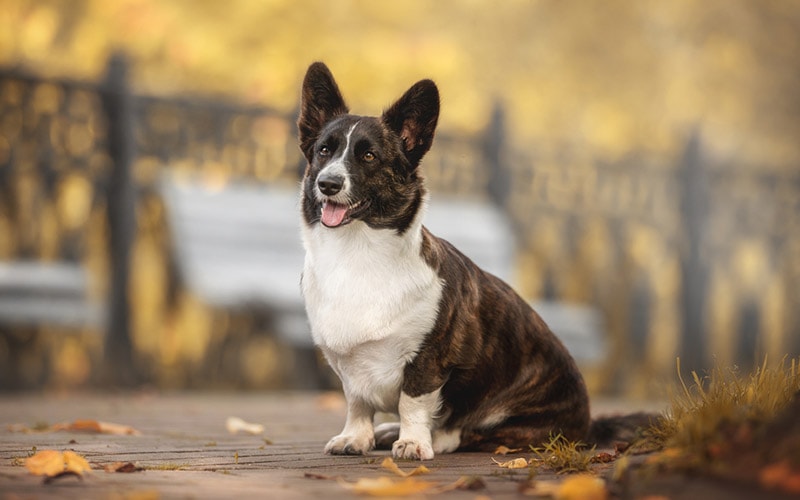
| Origin: | Wales, U.K. |
| Lifespan: | 12–14 years |
| Height: | 10.5–12.5 inches |
One of the oldest herding breeds developed in the U.K. is the Cardigan Welsh Corgi. Frequently confused with their younger cousin, the Pembroke Welsh Corgi, the Cardigan Welsh Corgi helped herd cattle in Wales around 1,000 years ago. These dogs also worked to protect the herd at night and helped with hunting and guarding.
They were freely bred with the Pembroke until 1934, when individual standards were developed for both breeds. A combination of brindle and white is one of the favorite coat colors and is a recognized standard.
12. Dutch Shepherd
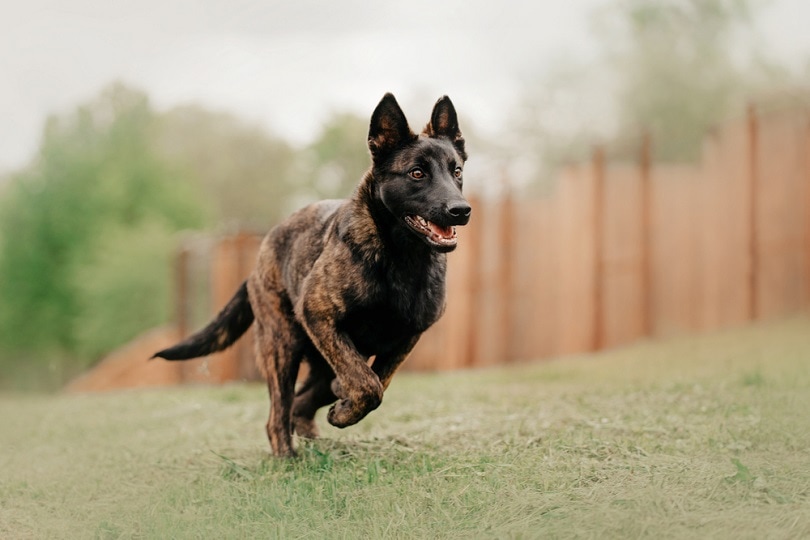
| Origin: | The Netherlands |
| Lifespan: | 11–14 years |
| Height: | 21.5–24.5 inches |
Shepherd dogs have always been adored for their versatility and hardiness. The Dutch Shepherd in particular is a keen worker and excels at herding cattle, protecting livestock and the farm, guarding the vegetable patch from chickens, and pulling carts.
The Dutch Shepherd is one of the few breeds that was developed to have a brindle coat. They can be solid yellow but are usually gold brindle or silver brindle. Although they were originally bred with a wide range of coat colors, the brindle coloring became the standard in 1914 as a way to distinguish the Dutch Shepherd from other popular shepherd breeds.
13. French Bulldog

| Origin: | Mid-19th century, U.K. |
| Lifespan: | 10–12 years |
| Height: | 11–13 inches |
Toy Bulldogs were popular among English lace workers during the Industrial Revolution in the mid-1800s and were a mascot of sorts in Nottingham in particular. When the lace industry came to an end, however, the dogs and the lace workers made their way to France. From there, the French Bulldog was developed from the original toy Bulldog breed, terriers, and Pugs, and they became known as the “Bouledogue Français.”
Brindle is one of the most common variations for French Bulldogs. Besides the popular solid colors like cream, fawn, and white, the Frenchie can be a mix of brindle and white, fawn brindle and white, or a single variation like brindle or fawn brindle.
14. Glen of Imaal Terrier

| Origin: | County Wicklow, Ireland |
| Lifespan: | 10–15 years |
| Height: | 12.5–14 inches |
The Glen of Imaal Terrier sounds like they’d fit right into a fantasy story filled with magic and long quests. Their love of their family and companionship supports this idea, but it wasn’t their original purpose.
These dogs were originally bred as badger hunters in County Wicklow, Ireland. The Glen of Imaal is a rocky and remote area, so a sturdy dog breed was required for hunting, working on farms, and even helping with cooking.
There’s little variation in their coat colors, with blue brindle and wheaten being the only two recognized by the AKC.
15. Great Dane

| Origin: | Germany |
| Lifespan: | 7–10 years |
| Height: | 28–32 inches |
Originally bred to hunt boars, the Great Dane is a German breed and was developed for their size and strength. The breed was highly favored by the German nobility and were fierce hunters and home guardians. Despite their intimidating size, though, they’re loyal and friendly and aren’t shy about cuddling up on your lap.
Great Danes have a range of recognized coat colors. Brindle is one of the most common and gives these massive, soft-hearted dogs an even more striking appearance.
16. Greyhound
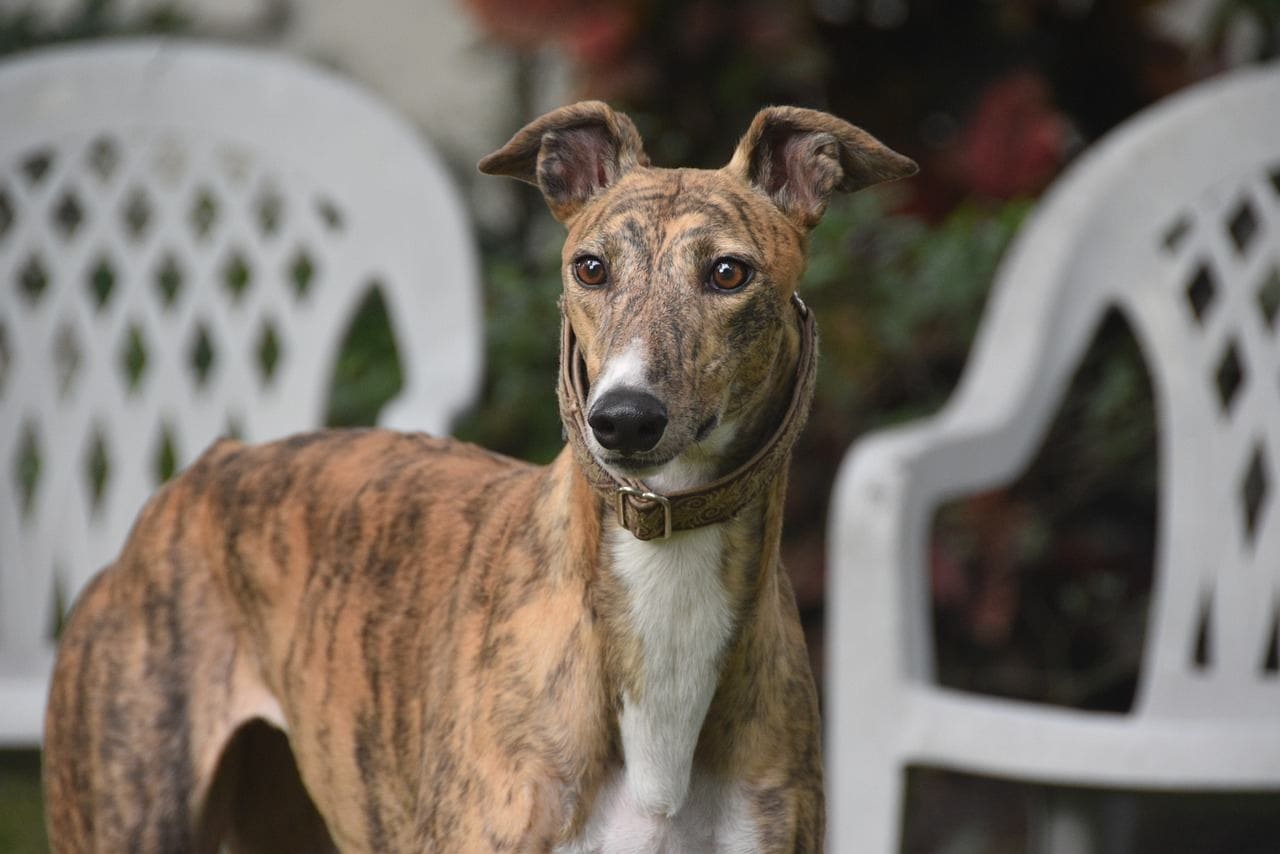
| Origin: | Ancient Egypt |
| Lifespan: | 10–13 years |
| Height: | 27–30 inches |
Well-known for their great speed over short distances, the Greyhound is a fleet-footed, slender hunter that was first developed in Egypt about 5,000 years ago. They were bred to be hardy enough to withstand the arid desert and fast enough to hunt the wildlife native to the area. Their slender, regal appearance also gained them favor with the pharaohs, and they were seen as “god-like” by the Egyptian people.
Black brindle, blue brindle, red brindle, and combinations of these with white are all frequently seen colors for the breed.
17. Mastiff
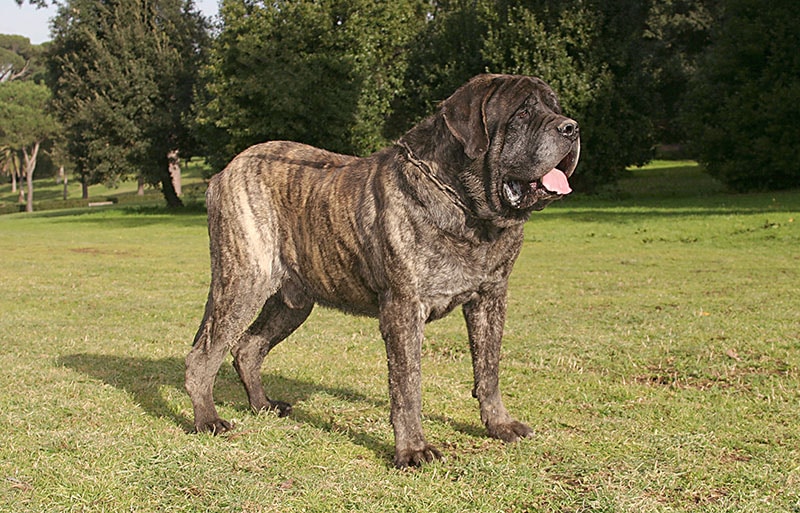
| Origin: | U.K. |
| Lifespan: | 6–10 years |
| Height: | 27.5–30 inches |
Mastiff-type dogs are among the oldest breeds in the world, and the Mastiff is one of the oldest. They were developed in England as big-game hunters, war dogs, and guardians and were even featured in Chaucer’s “Canterbury Tales.” The breed’s devotion and loyalty to their home also won the attention and favor of Julius Caesar during a Roman invasion, and they found their way to the Colosseum.
These days, they’re mellow guardians and companion dogs. Unlike many other breeds, they don’t have much variation in their coat colors. Besides brindle, the breed standard includes apricot and fawn.
18. Plott Hound
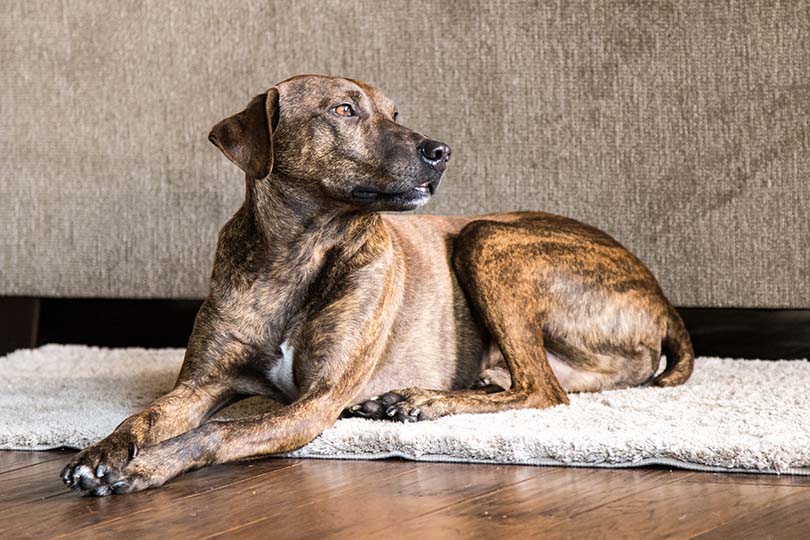
| Origin: | 18th century, U.S.A. |
| Lifespan: | 12–14 years |
| Height: | 20–25 inches |
Unlike other coonhound breeds that are recognized by the AKC, the Plott Hound is descended from the “Hanover hounds” that originated in Germany. They were developed by Johannes Plott, a German immigrant who moved to North Carolina in the 18th century. Plott wanted a breed that could hunt big game animals and bred the German dogs that he brought with him with the local American breeds.
Most of the Plott Hound’s coloring revolves around the brindle pattern. The recognized coat colors also include black, Maltese, and buckskin, though they’re mostly found in brindle in gray, blue, black, yellow, tan, orange, red, brown, chocolate, and liver.
19. Staffordshire Bull Terrier

| Origin: | 19th century, U.K. |
| Lifespan: | 12–14 years |
| Height: | 14–16 inches |
Like many other “bull type” breeds, the Staffordshire Bull Terrier, or Staffie, started as a pit fighter in the U.K. Before blood sports were banned in the 19th century, the Staffie and many other breeds were developed for their muscle and fighting skills in the ring. These days, they’re friendlier and less aggressive, but their history of bull-baiting and other illegal fights has given them a muscled and fierce appearance.
They’re a slightly older breed than the AmStaff, along with being smaller and lighter. The Staffordshire Bull Terrier is where the AmStaff gets their brindle coloring from. Unlike the American Staffordshire Terrier, though, the AKC standard for the Staffie only recognizes brindle and a mix of brindle and white.
20. Whippet
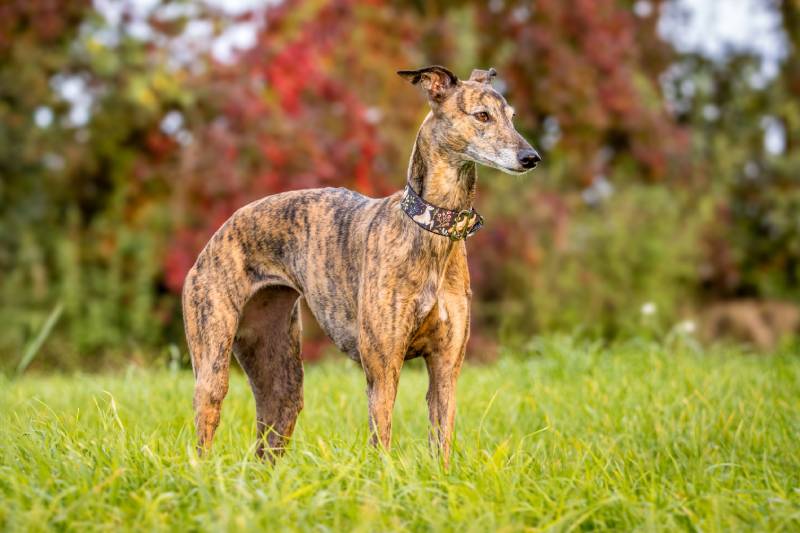
| Origin: | 19th century, U.K. |
| Lifespan: | 12–15 years |
| Height: | 18–21 inches |
Smaller but otherwise almost identical to the Greyhound, the Whippet was developed to be a “Poor Man’s Racehorse” in Victorian England. In an attempt to join in with hunting sports and dog races, the coal miners worked to breed a sighthound that was cheaper to own and maintain than the Greyhound but just as swift and light-footed. They’re not quite as fast as their cousins, but they give it their best shot!
Like the Greyhound, the Whippet can be found with a brindle coat pattern. The AKC recognizes blue brindle, red brindle, and fawn brindle.
Conclusion
Brindle is one of the most striking and unique patterns that a dog’s coat can be. It’s the result of a recessive gene that not all breeds carry, and those that do can just as easily be another, more dominant color. Despite this, many breeds are recognized to have brindle coats.
We hope that this list of brindle dog breeds has introduced you to new breeds that can show this coloring!
You Might Also Be Interested In:
Featured Image Credit: Deonna Carroll, Shutterstock







